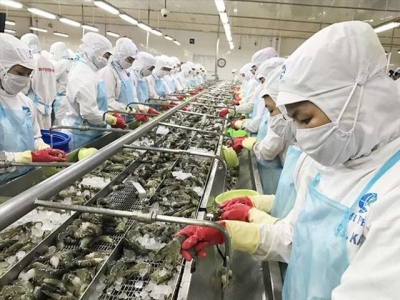Is $40 billion worth of farm exports beyond reach?

The high agricultural production growth rate in Q1 2018 has prompted government to set a target of exporting $40 billion worth of farm produce this year.
Shrimp is one of key export items
However, natural calamities and overproduction could upset the plan.
Unexpected rising stars
According to the agriculture ministry, the agriculture – forestry – fisheries sector grew by 4.05 percent in the first quarter of 2018, a 13-year high. The export turnover also increased sharply by 9.6 percent compared with the same period last year to $8.7 billion.
Cultivation, with a sharp growth rate of 5.16 percent, made a great contribution to the strong rise of the sector. Analysts commented that rice farming ‘woke up’ in 2017 and jumped in the first three months of the year with total rice output reaching 11.2 million, an increase of 570,000 tons over the same period last year.
The rice export price is on the rise thanks to improved quality. It is expected that Vietnam will export 6.5 million tons of rice this year.
Another ‘rising star’ is vegetable and fruit fruit sector, with export turnover reaching $930 million in the first quarter, up by 33 percent over the same period last year.
Seafood and wooden furniture, Vietnam’s two key export items, also gained impressive export growth rates with export turnover of $1.7 billion and $1.87 billion, respectively.
Do Ha Nam, chair of Intimex, a big exporter of farm produce, said he believes the $40 billion target is attainable.
The cashew nut supply globally is still low so the export price is expected to increase. The demand for rice is also predicted to increase. Vietnam hopes it can export more than 6 million tons.
“The export of fruits, seafood and rubber are on the rise and if the export value of coffee, cashew nut and rice increases by 5-10 percent, the $40 billion goal is within reach,” he said.
However, Nam thinks coffee export turnover in 2018 would be the same as 2017, about $3.2 billion, even though the output is predicted to increase by 10 percent.
Meanwhile, an analyst expressed his concern about the oversupply of some kinds of farm produce. This occurs regularly when farm produce price drops dramatically in high harvesting season, bringing big losses to farmers. Social organizations have to call on people to buy farm produce to help ease farmers’ losses.
According to Nguyen Anh Duong from the Central Institute of Economic Management, every two years of low GDP growth rates is followed by one year of high GDP growth rate. And the average growth rate of three consecutive years is stable, with no sharp rise or fall.
Related news
 Central provinces target 2.5 million tonnes of rice in upcoming crops
Central provinces target 2.5 million tonnes of rice in upcoming crops South Central and Central Highlands provinces to strive to produce at least 2.5 million tonnes of rice in this year’s upcoming crops.
 Clean production will help Vietnamese fruit compete with imports
Clean production will help Vietnamese fruit compete with imports Shifting to clean production is the right way for Vietnamese fruits to compete with the rising inflow of imports, both consumers and local fruit growers said
 Vietnam gearing up for upcoming lychee and longan harvests
Vietnam gearing up for upcoming lychee and longan harvests Bac Giang and Hai Duong provinces are projected to produce 150,000 tonnes and 55,000 tonnes of lychees respectively, while the longan yield of Hung Yen province